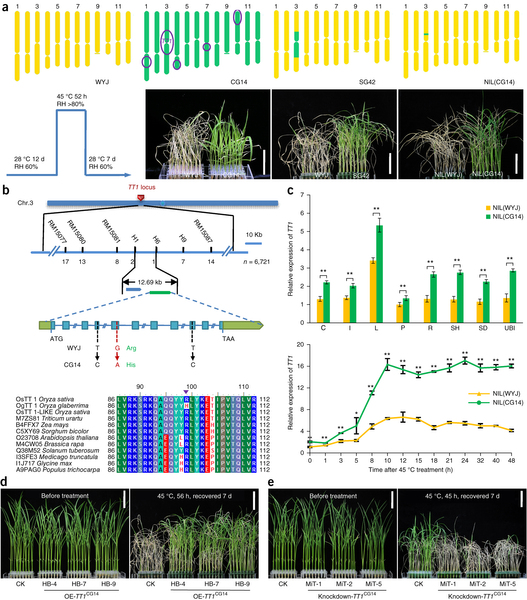

Climate change, mainly in the form of global warming, has been causing a reduction in the amount of harvests, resulting in widespread risks of food insecurity and social problems. Maintaining the ability to feed the world’s population under conditions of global warming is a long-term challenge; understanding the molecular basis and genetic breeding of thermotolerant crops is a fundamental way to help meet this challenge.
Recently, a team led by Lin Hongxuan, at the Shanghai Institute of Plant Physiology and Ecology (SIPPE), Chinese Academy of Sciences, reported the identification of a major QTL from African rice (Oryza glaberrima), Thermo-Tolerance 1 (OgTT1), which is responsible for the strong ability of African rice to adapt to heat stress. This work, entitled “Natural Alleles of a Proteasome α2 Subunit Gene Contribute to Thermotolerance and Adaptation of African Rice”, was published in Nature Genetics on May 18, 2015.
Using a map-based cloning approach, and after more than seven years of work, Dr. Li Xinmin from the lab of Lin Hongxuan and his colleagues successfully cloned OgTT1, which encodes an α2 subunit of the 26S proteasome involved in the degradation of ubiquitinated proteins that were denatured due to heat stress. Biochemical analysis demonstrated that OgTT1 enhances the degradation efficiency of proteasome, thereby facilitating the elimination and recycling of cytotoxic denatured proteins and the maintenance of heat response processes. That is to say, OgTT1 protects plants from heat stress by balancing protein homoeostasis and with a series of protective responses.

Interestingly, researchers elucidated that TT1 plays a key role in local adaptation during rice evolution, which may help explain how climate selection contributes to plant geographical distribution and evolution. More importantly, they demonstrated the potential of using OgTT1 to breed thermotolerant rice by marker-assisted selection (MAS) or transgenic techniques, as this gene increases rice grain yields up to 5~10-fold under heat stress without affecting any visible phenotype including agronomic traits. In addition, overexpression of OgTT1 in other plant species also greatly enhances their tolerance to heat stress, indicating that OgTT1 could be widely used to breed more thermotolerant cultivars of plants such as cruciferous vegetables and graminaceous crops including wheat.
These findings, including the novel insights about basic scientific issues and their substantial potential for practical applications, will surely bring new concepts to enhance crop productivity under global warming conditions.